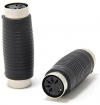laxu
Fractal Fanatic
Other than a design flaw in the WIDI, I would find it hard to believe that so many WIDI Master owners would run into the same problem with this specific configuration. So one of the devices is not working right if the WIDI heats up at 5V. Does anyone have an Axe-Fx 3 to try so they could see if that works differently? Also why 3.3V on Axe-3 vs 5V on FM3?
There seems to be a new firmware 1.3.0.7 out for the WIDI and I tried updating both my dongles to use that and no change. It doesn't take much time for the dongle to really heat up after FM3 is started.
Personally I would not be at all surprised if the problem is on CME's side because their WIDI app software is pretty flaky, firmware updates are not done that great and getting the groups feature to work is equally messy.
There seems to be a new firmware 1.3.0.7 out for the WIDI and I tried updating both my dongles to use that and no change. It doesn't take much time for the dongle to really heat up after FM3 is started.
Personally I would not be at all surprised if the problem is on CME's side because their WIDI app software is pretty flaky, firmware updates are not done that great and getting the groups feature to work is equally messy.
Last edited:




